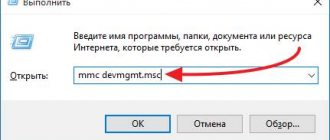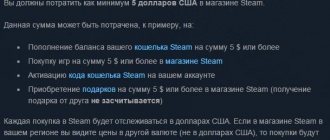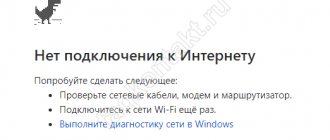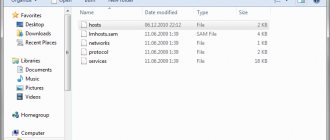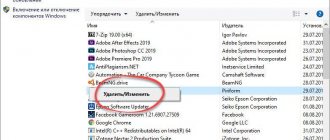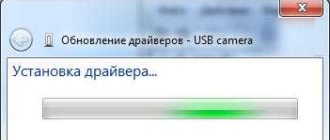You can often encounter situations when a user connects a mobile device to a computer via a USB cable, but the system does not recognize the device and even displays an error message. And this, unfortunately, applies not only to the simplest phones, but also to modern tablets, smartphones and even cameras. How to identify an MTP USB device, make it visible and fully operational, is then proposed to be considered in as much detail as possible. Let's try to apply several classic methods and solutions that are offered by users on the Internet.
Windows 7 error: “USB device MTP. Refusal". General essence of the problem
I would like to note right away that the problem is that the mobile device is not detected by the operating system solely as a drive (neither the internal partition nor the removable card is visible).
Many users think that the main reason is that the USB MTP device driver is not working properly. Yes, indeed, such a situation can be observed, but only partially. Sometimes the problem may be in the settings of the device itself or even in the Windows system registry settings. In addition, if some additional components and updates are not installed on the system to ensure the correct operation of connected devices of this type, the error may also appear.
The software for the device was not installed
Forbes publishes excerpts from Gladwell’s book “Geniuses and Outsiders” https://www.rb.ru/inform/112697.html:
What we call talent is the result of a complex interweaving of ability, opportunity, and chance advantage. If white crows win because of special opportunities, do these opportunities follow some pattern? As it turns out, yes.
Twenty years ago, psychologist Anders Eriksson and two colleagues conducted a study at the Academy of Music in Berlin. The violin students were divided into three groups. The first included stars, potential world-class soloists. The second group includes those who were rated as promising. The third group includes students who could hardly become professional musicians; at best, music teachers at school. All participants were asked one question: how many hours have you practiced since you first picked up the violin until today?
Almost all students started playing at about the same age - about five years old. For the first few years, everyone studied about two to three hours a week. But from the age of eight, differences began to appear. The best students practiced more than all the others: by the age of nine, six hours a week, by twelve, eight hours, by fourteen, sixteen, and so on until the age of twenty, when they began to study—that is, purposefully and concentratedly improve their skills—more than thirty hours a week. By the age of twenty, the best students had accumulated up to 10,000 hours of study. Average students had 8,000 hours in their luggage, while future music teachers had no more than 4,000.
Erickson and his colleagues then compared professional and amateur pianists. The same pattern was revealed. Amateurs never practiced more than three hours a week, so by the age of twenty they had no more than 2,000 hours of practice under their belts. Professionals, on the other hand, played more and more every year, and by the age of twenty each of them had 10,000 hours of exercise under their belt.
It is curious that Erickson was unable to find a single person who achieved a high level of skill without putting in much effort and practicing less than his peers. Those who worked hard but did not get ahead simply because they did not have the necessary qualities were also not identified. One could only assume that the people who were able to get into the best music schools differed from each other only in how hard they worked. That's all. By the way, the best students did not just work harder than everyone else. They worked much harder.
The idea that it is impossible to achieve mastery in complex activities without extensive practice has been expressed more than once in studies on professional competence. Scientists have even come up with a magic number that leads to mastery: 10,000 hours.
Neuroscientist Daniel Levitin writes: “The picture that emerges from numerous studies is that, no matter what the field, it takes 10,000 hours of practice to achieve a level of mastery commensurate with world-class expert status. Whoever you take - composers, basketball players, writers, speed skaters, pianists, chess players, hardened criminals, and so on - this number occurs with surprising regularity. Ten thousand hours is about three hours of practice a day, or twenty hours a week for ten years. This, of course, does not explain why some people benefit from exercise more than others. But no one has yet come across a case where the highest level of skill was achieved in less time. It seems like it takes exactly that long for the brain to absorb all the necessary information.”
This applies even to child prodigies. Here is what psychologist Michael Howe writes about Mozart, who began writing music at the age of six: “Compared with the works of mature composers, Mozart’s early works are not distinguished by anything outstanding. There is a high probability that they were written by his father and later corrected. Many of little Wolfgang's works, such as the first seven piano concertos, are largely compilations of works by other composers. Of the concertos that belong entirely to Mozart, the earliest, considered great (No. 9, K. 271), was written by him at the age of twenty-one. By this time, Mozart had been composing music for ten years.”
Music critic Harold Schonberg goes even further. Mozart, he said, “developed late,” since he created his greatest works after twenty years of composing music.
It also takes about ten years to become a grandmaster. (The legendary Bobby Fischer completed this task in nine.)
One more interesting detail should be noted: 10,000 hours is a very, very long time. Young people are not able to work that many hours alone. We need the support and help of parents. Poverty is another obstacle: if you have to work part-time to make ends meet, there is simply no time left for intensive studies.
Silicon Valley old-timers call Bill Joy the Edison of the Internet. Joy bears this nickname by right; he founded Sun Microsystems, one of the companies that helped usher in the computer revolution.
In 1971, he was a tall, skinny guy of 16 years old. He entered the University of Michigan to study engineering or mathematics, but at the end of his first year he accidentally stopped by the university's computer center, which had just opened.
The center is housed in a low brick building with a dark glass facade. In the spacious room, lined with white tiles, there were huge computers. They reminded one of the teachers of the scenery from 2001: A Space Odyssey. Nestled to the side were dozens of key punchers, which in those days were used as computer terminals. In 1971 they were perceived as a real work of art.
“As a child, he wanted to know everything about everything,” says Bill’s father. “We answered if we knew the answer.” And if they didn’t know, they gave him a book.” Upon entering college, Joy scored a perfect score in mathematics. “There was nothing particularly difficult there,” he says matter-of-factly. “There’s still plenty of time to double check everything.”
In the 1970s, when Joy was learning the basics of programming, the computer took up an entire room. One computing machine—with less power and memory than your microwave—cost about a million dollars. And that's in 1970s dollars. There were few computers, and it was difficult and expensive to get access to working with them. Moreover, programming was an extremely tedious task. Programs at that time were created using cardboard punch cards. The key puncher typed lines of codes onto the card. The complex program consisted of hundreds, if not thousands, of these cards, stored in huge stacks. After writing the program, it was necessary to gain access to the computer and give stacks of cards to the operator. He signed you up in a queue, so you could pick up the cards only after a few hours or a day, depending on how many people were in front of you. If even the slightest error was found in the program, you took the cards, found it and started all over again.
In such conditions, it was extremely difficult to become an outstanding programmer. Of course, there was no question of becoming a real specialist in his early twenties. If for every hour spent on the computer there are only a few minutes, how could one accumulate 10,000 hours of practice? “By programming with cards,” recalls a computer specialist of that era, “you were not learning programming, but patience and attentiveness.”
This is where the University of Michigan comes into play. For the mid-1960s, this was an atypical educational institution. He had money and a long computer history. “I remember we bought a semiconductor storage device. This was in sixty-nine. Half a megabyte of memory,” recalls Mike Alexander, one of those who created the university computer system. Today, half a megabyte of memory costs four cents and fits on your fingertip. “I think at that time this device cost several hundred thousand dollars,” continues Alexander, “and was the size of two refrigerators.”
Most universities couldn't afford this. But Michigan could. But more importantly, it was one of the first universities to replace cardboard cards with a modern time-sharing system. This system came about because computers became much more powerful by the mid-1960s. Computer scientists discovered that it was possible to train a machine to process hundreds of jobs at once, which meant that programmers no longer had to carry stacks of cards to operators. It was enough to organize several terminals, connect them to a computer via a telephone line, and all programmers could work at the same time.
This is how a witness of those events describes the division of time: “It was not just a revolution, but a real revelation. Forget about operators, piles of cards, queues. Thanks to time sharing, you could sit at a teletype, type in commands and get an answer instantly.”
The University of Michigan was one of the first in the country to introduce a time-sharing system called MTS (Michigan Terminal System). By 1967, a prototype system was put into operation. In the early 1970s, the university's computer facilities allowed hundreds of programmers to work simultaneously. “In the late sixties, early seventies, no university could compare to Michigan,” Alexander says. — Except, perhaps, the Massachusetts Institute of Technology. Well, maybe also Carnegie Mellon and Dartmouth College.”
When freshman Bill Joy fell in love with computers, it turned out that, by a stroke of luck, he was studying at one of the few universities in the world where a seventeen-year-old student could program to his heart's content.
“Do you know the difference between punch card programming and time sharing? Joy asks. “In the same way that correspondence chess differs from a blitz game.” Programming has become fun.
“I lived on the north campus, and the computer center was located there,” our hero continues. - How much time did I spend there? Phenomenally a lot. The center worked 24 hours a day, and I sat there all night and returned home in the morning. In those years I spent more time at the center than in classes. All of us, obsessed with computers, were terribly afraid of forgetting about lectures and, in general, that we were studying at the university.”
There was one problem: all students were allowed to work on the computer for a strictly defined time - about an hour a day. “There was nothing more to count on,” these memories amused Joy. - But someone figured out that if you put the time symbol t, then the equal sign and the letter k, then the countdown will not start. This is the error in the program. You set t=k and sit there even indefinitely.”
Notice how many opportunities Bill Joy has had. He was lucky enough to go to a university with visionary leadership, so he learned programming using a time-sharing system, without punch cards; a bug had crept into the MTS program, so he could sit at the computer as much as he wanted; the computer center was open 24 hours a day, so he could spend all nights there. Bill Joy was exceptionally talented. He wanted to study. And this cannot be taken away from him. But before he became an expert, he had to have the opportunity to learn everything he had learned.
“In Michigan, I programmed eight to ten hours a day,” Bill admits. — When I entered Berkeley, I devoted days and nights to this. I had a terminal at home, and I stayed up until two or three in the morning, watching old films and programming. Sometimes he fell asleep at the keyboard,” he showed how his head fell on the keyboard. — When the cursor reaches the end of the line, the keyboard makes this characteristic sound: beep-beep-beep. After this is repeated three times, you need to go to bed. Even at Berkeley I was still a greenhorn. By my second year I had risen above the average level. That’s when I started writing programs that are still used today, thirty years later.” He thinks for a second, mentally doing the math, which doesn't take much time for a man like Bill Joy. University of Michigan in 1971. Active programming for the second year. Add to this the summer months and the days and nights devoted to this activity in Berkeley. “Five years,” Joy sums it up. “And I only started at the University of Michigan. So, probably... ten thousand hours? I think so."
Can this rule of success be called common to everyone? If you look at the history of every successful person, is it always possible to find the equivalent of the Michigan Computer Center or the All-Star Hockey Team - some special opportunity for enhanced learning?
Let's test this idea with two examples, and for the sake of simplicity let them be the most classic: the Beatles, one of the most famous rock groups of all time, and Bill Gates, one of the richest people on the planet.
The Beatles—John Lennon, Paul McCartney, George Harrison and Ringo Starr—came to the United States in February 1964, ushering in the British Invasion of the American music scene and producing a string of hits that changed the sound of popular music.
How long did the band members play before coming to the United States? Lennon and McCartney began playing in 1957, seven years before arriving in America. (Incidentally, ten years passed from the founding of the group to the recording of such famous albums as Sgt. Pepper's Lonely Hearts Club Band and The White Album.) And if we analyze these long years of preparation even more carefully, the story of the Beatles takes on painfully familiar features. In 1960, when they were still an unknown school rock band, they were invited to Germany, to Hamburg.
“In those days there were no rock and roll clubs in Hamburg,” he wrote in the book “Scream!” (Shout!) band historian Philip Norman. — There was one club owner named Bruno, who had the idea of inviting various rock bands. The scheme was the same for everyone. Long speeches without pauses. Crowds of people wander here and there. And musicians must play continuously to attract the attention of the public. In the American red light district, this action was called non-stop striptease.”
“There were a lot of bands from Liverpool playing in Hamburg,” Norman continues. - And that's why. Bruno went looking for bands in London. But in Soho he met an entrepreneur from Liverpool, who ended up in London by pure chance. And he promised to organize the arrival of several teams. This is how contact was established. Ultimately, the Beatles established contact not only with Bruno, but also with the owners of other clubs. And then they often went there, because in this city there was a lot of drinking and sex waiting for them.”
What was so special about Hamburg? They didn't pay very well. The acoustics are far from perfect. And the public is not the most demanding and grateful. It's all about the amount of time the band was forced to play.
Here's what Lennon said about performing at the Hamburg strip club Indra in an interview after the band broke up:
“We were getting better and gaining confidence. It couldn’t be otherwise, because we had to play all evening long. The fact that we played for foreigners was very helpful. To reach them, we had to try our best, put our soul and heart into the music.
In Liverpool we performed for an hour at best, and even then we only played hits, the same ones at every performance. In Hamburg we had to play for eight hours straight, so like it or not, we had to try.”
Eight hours?
And here’s what Pete Best, who was the band’s drummer at that time, recalls: “As soon as news of our performance became known, crowds of people filled the club. We worked seven evenings a week. At first we played non-stop until half past midnight, that is, until the club closed, but when we became more popular, the audience didn’t leave until two o’clock.”
Seven days a week?
From 1960 to the end of 1962, the Beatles visited Hamburg five times. On their first visit, they worked 106 evenings, five or more hours per evening. On their second visit they played 92 times. The third time - 48 times, spending a total of 172 hours on stage. On their last two visits, in November and December 1962, they performed for another 90 hours. Thus, in just a year and a half they played 270 evenings. By the time their first great success awaited them, they had already given about 1,200 live concerts. Can you imagine how incredible this figure is? Most modern bands don't play that many concerts throughout their entire existence. The harsh school of Hamburg is what distinguished the Beatles from everyone else.
“They left with nothing to show for it and came back in great shape,” Norman writes. “They learned more than just endurance. They had to learn a huge number of songs - cover versions of all the works that exist, rock and roll and even jazz. Before Hamburg they did not know what discipline was on stage. But when they returned, they played in a style unlike any other. It was their own find."
Bill Gates is no less famous than John Lennon. A brilliant young mathematician discovers programming. Drops out of Harvard University. Together with friends he creates a small computer company, Microsoft. His genius, ambition and determination make him a software giant. This is Gates' story in the most general terms. Now let's dig a little deeper.
Gates' father is a wealthy lawyer from Seattle, his mother is the daughter of a wealthy banker. Little Bill was precocious and was bored in class. In seventh grade, his parents pulled him out of public school and sent him to Lakeside, a private school for the children of Seattle's elite. During Gates' second year, a computer club opened at school.
“The Motherboard had an annual charity sale, and the question was always what to do with the proceeds,” Gates recalls. “Sometimes they went to pay for a summer camp for children from poor areas. Sometimes they were given to teachers. And that year, my parents spent three thousand dollars on buying a computer terminal. It was installed in a small room, which we subsequently occupied. Computers were a novelty for us.”
In 1968, this was undoubtedly a novelty. In the 1960s, most colleges did not have computer centers. But what’s even more remarkable is what kind of computer the school purchased. Lakeside students did not have to learn programming using the labor-intensive system that almost everyone used at the time. The school installed the so-called ASR-33 teleprinter, a time-sharing terminal that was directly connected to the computer at . Bill Joy had the rare, unique opportunity to learn time-sharing programming as a freshman. In 1971, Bill Gates began real-time programming in the eighth grade of school and three years earlier.
After installing the terminal, Gates moved into the computer lab. Buying time to work on the computer to which the ASR was connected was expensive even for such a wealthy establishment as Lakeside, and soon the mother committee's money ran out. The parents collected more, but the students spent even that. Soon, a group of programmers from the University of Washington founded the Computer Center Corporation (or C-Cubed) and began selling computer time to local companies. By luck, the son of one of the owners of the company, Monica Rona, studied at Lakeside in a grade above Bill. Rona invited the school's computer club to test the company's software on weekends in exchange for free computer time. Who would refuse! Now, after school, Gates took the bus to the C-Cubed office and worked there until late in the evening.
This is how Bill Gates describes his school years: “I was obsessed with computers. I skipped physical education. I sat in the computer class until nightfall. Programmed on weekends. We spent twenty to thirty hours there every week. There was a period when we were banned from working because Paul Allen and I stole passwords and hacked into the system. I was left without a computer for the whole summer. I was fifteen or sixteen years old then. And then Paul found a free computer at the University of Washington. The machines were located in the medical center and at the physics department. They worked 24 hours a day, but between three in the morning and six in the morning no one occupied them,” Gates laughs. “That’s why I’m always so generous to the University of Washington.” They let me steal so much computer time from them! I would leave at night and walk to the university or take the bus.” Years later, Gates' mother said, "We couldn't figure out why he was so hard to wake up in the morning."
One day, one of Bill's computer acquaintances, Bud Pembroke, was approached by the technology company TRW, which had just signed a contract to install a computer system at a huge power plant in southern Washington State. TRW urgently needed programmers familiar with the specialized software used in power plants. At the dawn of the computer revolution, programmers with such knowledge were not easy to find. But Pembroke knew exactly who to turn to—the kids at Lakeside School had put in thousands of hours of computer work. Bill Gates was a high school senior who convinced his teachers to excuse him from class for an independent research project at a power plant. There he spent the entire spring developing code under the supervision of John Norton. He, according to Gates, told him as much about programming as no one had ever told him.
These five years, from eighth grade to graduation from high school, became a kind of Hamburg for Bill Gates. Any way you look at it, he had even more amazing opportunities than Bill Joy.
Read more on Forbes.ru: https://www.forbes.ru/forbes/issue/2009-04/7255-pravilo-10000-chasov
Initial actions with the registry
So, before downloading the MTP USB device driver, you can take, so to speak, preventive measures using the system registry, since some installed keys may contain prohibitions on identifying mobile devices.
First of all, call the editor (regedit in the “Run” menu) and go to the HKLM branch. Through the SOFTWARE section and control directories, we move to the final directory, as shown in the image above. On the right there is the UpperFilters key, which is exactly what is stopping us. We delete the entry, exit the editor and reboot the system. After this, as a rule, when you connect the device to a computer or laptop, the drivers, if they were not present, will be installed automatically, and the MTP USB device itself becomes visible in the system.
Installation on Linux (Ubuntu)
On Linux systems, due to their specificity, installing MTP Device drivers is somewhat more complicated. As an example, consider this process for the Ubuntu version when installing the driver for Nexus.
So, we use the command window, in which we first write sudo nano -w /etc/udev/rules.d/51-andro “, after which we sequentially execute the lines sudo apt-get install mtpfs, sudo mkdir/media/GNexus and sudo chmod 775 /media/GNexus.
Next, connect the gadget to the computer and enter sudo mtpfs -o allow_other /media/GNexus. That's it, now, using Nutilus, you can start moving any files and folders. Yes, the most important thing. When all operations are completed, remember to use the final command sudo umount mtpfs.
Installing or updating the driver
But it also happens that the above key is initially absent from the registry, and devices are not detected under any pretext. What to do in such a situation?
Here you need to, with the device connected to the computer, go to the “Device Manager”, find your device marked with a yellow triangle, and through the RMB menu select the driver update (you can also use the properties section). When the system starts making recommendations, you should select only compatible drivers. If this does not help, download the universal MTPPK driver from the Internet, install it yourself, or point the system to the full path to the saved file.
Sometimes a non-working MTP USB device can be identified if you select the hardware ID in the information drop-down list on the details tab, and then search for a driver on the Internet using the longest string containing the DEV and VEN identifiers. It goes without saying that after downloading, you will also have to install the driver yourself.
Installation
Functionality
MTP support in Linux is provided by installing the . It can be installed separately and used to access devices. However, there are a large number of packages available that use it as a dependency and add convenient (eg file manager) functionality and compatibility with specific types of devices, which includes speeding up data transfers.
Each of these packages implements a user-space file system:
- AUR - confirmed compatibility with devices newer than Android 4+
- AUR - confirmed compatibility with devices newer than Android 3+
- AUR
- — MTP client with ascetic UI
Their common goal is to expand functionality and increase productivity. Since there are many different USB devices available, you may want to check which one is best for you.
Important: it does not support new Android devices very well - data transfer freezes and problems with remote viewing of the file system often occur. Poor performance expected for all devices
Moreover, if your USB cable is damaged, programs using libmtp may crash or hang until you unplug your device. To connect devices, it is recommended to use USB Mass Storage (if possible), or use ADB (for example, AUR) to transfer files. It delivers strong performance on most devices and supports additional Android-specific features (such as installing APKs, managing packages on the device, backing up data, or accessing the device shell).
Tip: After installing MTP-related packages, it is recommended to restart your computer.
Integration with file managers
To view the contents of your Android device's storage via MTP in the file manager, install the appropriate plugin:
- For file managers that use GVFS (GNOME Files, Xfce's Thunar), set for MTP support and for PTP support.
- For file managers that use KIO (KDE's Dolphin), install (PTP support is already included in it).
There is also an alternative to plugins: a minimalistic MTP client.
After installing the necessary packages, your device should appear in the file manager automatically, and you will be able to access files from a URL like this: .
Note: If you have a newer Android device that does not support UMS (USB storage) and you find it very slow or not working correctly, then you can install AUR from AUR.
Installation of additional system components
Sometimes, even if there is a working driver, the error may occur again and again. It is believed that this situation is largely due to the lack of special components of the operating system itself.
The fix for the error is to download the Windows Media Feature Pack or its missing elements from the official Microsoft website and then install it. User reviews indicate that sometimes this works.
Other Possible Causes
Sometimes, even all of the listed methods cannot give the desired result. Drivers are installed either crookedly or not installed at all. The reason for such a problem may lie not in third-party software, but in the Windows operating system itself. Versions of Windows XP/7 that are too old may simply not support modern printing equipment. The way out of this situation is to download the latest cumulative updates from the official Microsoft website, or update Windows to the latest version.
An equally common cause of problems may be a conflict between drivers and installed utilities. You need to completely remove all programs and drivers from the previous printer before connecting new equipment.
When installing any third-party software, the operating system checks files for the presence of a digital signature. This helps keep your computer secure, but can be a problem when installing unsigned printer drivers. To get rid of this problem in Windows XP, you need to open system properties using the context menu on the “My Computer” icon on the Desktop. On the Hardware tab, select Driver Signing. Opposite it, you need to set the value “Warn - offer a choice of action every time.”
In Windows 7/8.1/10, slightly more complex steps are required.
Often, a “Plug and Play” error can be the reason why a USB printer may not install. This problem can be fixed as follows:
- Open Device Manager and view the full list of connected equipment
- In the “Unknown devices” section you need to find the printer you need, right-click on it and select “Update driver”
- Click the “No, not now” button, and then disconnect the printer from the computer
- Insert the media with official drivers, check the box next to the option to automatically download software and click the “Next” button
- Install the software, and when prompted to connect the device, connect the USB cable.
Sometimes, the Plug and Play service may simply be disabled, which causes the automatic installation of drivers to fail. To enable it, you need to open the “Run” window (Win + R keys), and then enter the “msconfig” command. Next to the “Plug and Play” service, you need to check the box, and then restart the computer.
